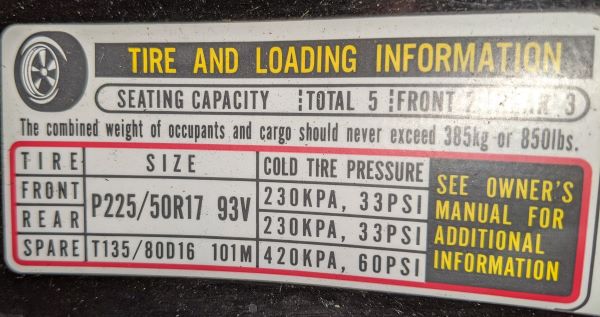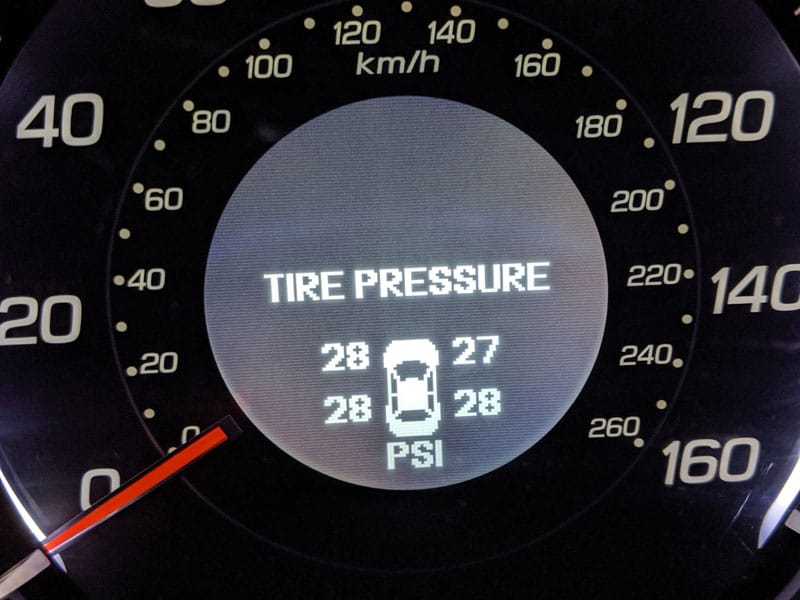Table of Contents
What Should Your Car Tire PSI Be At? What Does Car Tire PSI Mean?
If you own a newer car then it’s likely that your car came with a tire pressure monitoring system or TPMS. However, a lot of people don’t really pay attention to this alert and end up driving with the TPMS light on all the time. This will ultimately put you at risk as the main point of the system is to alert you that you may have a flat tire. But what does car tire PSI mean?
The point of this system is to alert you that one or multiple tires are not inflated to the proper pounds per square inch level (PSI). If you do not know what PSI stands for a PSI reading is used to indicate how much air is currently in the tire.
The higher the pounds per square inch the more air is present inside of the tire and the stiffer the tire will be. The lower the PSI reading the less air is in the tire and the softer the tire will be.
Each car is different and vehicle manufacturers will recommend different PSI ratings depending on the type of vehicle. So how do you find the correct PSI or tire pressure for your specific vehicle
How Do I Find the Correct Tire Pressure for My Vehicle?
The easiest and quickest way to find out what tire pressures are recommended for your car is to look in the driver’s door sill after opening your door. On the majority of vehicles, you will find a sticker indicating what the front tire pressure should be along with what PSI the back tires should be inflated to. That sticker should look like the one below.

If your car has been repainted or that sticker in the door sill is not there you can also check the owners manual if you have that for the proper recommended tire PSI ratings. If you don’t have your owner’s manual handy you can also search online for your specific vehicle and model year to determine what your vehicle manufacturer recommends.
Vehicle manufacturers will do extensive testing with different tire pressures so for the best performance, ride, and handling characteristics you would want to inflate your tires to what they recommend. If you inflate your tires over what is recommended this will usually result in a rougher ride as the sidewall of your tires will be stiffer.
If you don’t inflate your tires all the way to the recommended tire pressure then this will result in you getting worse gas mileage because the contact surface of the tires will be increased by the deflated tires.
What If Your Are Using Different Tires Than What the Vehicle Manufacturer Recommends?
Another common question from people is what if I’m no longer using the same brand of tire that came on my car? Most people will end up having to swap out tires during the ownership of a vehicle and likely won’t go with the same brand of tire that they are replacing. That is totally fine. If this applies to you then you should still inflate your tires to what the vehicle manufacturer recommends.
Different tires may have different max PSI ratings depending on the type of tire. However, you would want to inflate your tires to whatever your vehicle manufacturer recommends. This is going to give you the best ride quality for your specific vehicle.
How Do I Check My Tire Pressure?
On many new vehicles equipped with a TPMS system, you can check your tire pressure through one of the menus in your car. You may have to check through your owners manual or online to see if that feature is available on your specific vehicle.
To learn more about how to check your tire pressure and more about tire pressure in general check out my other article on how to check your tire pressure.
I have a 2009 Acura TSX and it allows you to see what PSI each individual tire is inflated to by cycling through the menu to the tire category. If your car did not come with a system to allow you to monitor the PSI of each tire then you would need to check your tire pressure manually with a tire pressure gauge.
Who Makes the Most Accurate Tire Pressure Gauge?
You can buy an old school tire pressure gauge that you connect to the valve of your tire. As air is let out of the valve stem it will extend a stick that will then indicate what the tire pressure is. The other option is buying a digital tire pressure gauge that you can stick on the end of your tire valve stem and it will read back the PSI rating on the digital screen.
The digital pressure gauge will obviously cost more than the old school tire pressure gauge but provides a more accurate reading. If you are interested in checking out the current prices of the digital pressure gauge I purchased on Amazon click here.
If you don’t have access to a free air pump at your local gas station the best way to keep your car tires inflated is by buying a portable tire pump. With this a portable tire air pump you can air up your tires from virtually anywhere as long as you still have power to your car.
Most portable tire pumps will be able to be plugged into your cigarette lighter outlet to provide power to the air pump. You can then connect the pump to your individual tires to air them up pretty much anywhere.
Having a portable tire pump may come in hand if you have a slow leak, a small pin-sized hole in your tire, or a deflated spare tire. I ended up going with the EPAuto portable air pump pictured above. If you are interested in checking out the current prices of that portable air pump on Amazon click here.
What Effects Car Tire PSI Pressure?
The main factor that will impact your tire pressure is the ambient temperature outside. As the air outside decreases in temperature, the air molecules inside of your tires begin to slow down. When this happens the tire pressure inside of the tire will begin to slowly fall because of the decreased movement of the air molecules.
That is why it’s most common to see your tire pressure light on days where the temperature decreased significantly. You may also notice this happening if you park outside instead of in a temperature-controlled garage.
Should Front and Back Tires Have The Same Tire Pressure?
According to most vehicle manufacturers, the front tires should be inflated to a different PSI rating than the back tires. The theory behind this is that the front of your car is likely heavier (unless you have a car with the engine in the back) because the engine is over the front wheels.
The other factor for different PSI ratings between front and back tires is the spring rates used between the front and back of your vehicle. Typically the spring rates on the front of your vehicle will be different than the ones on the back of the vehicle which also has to do with the weight distribution of the vehicle.
With that said I will usually inflate both front and back tires to about the same PSI. My vehicle manufacturer recommends that the front tires be inflated to 33 PSI and recommend the back tires to be inflated to 32 PSI so I will just inflate them all to 33 PSI.
Car Tire PSI – Related Questions
What does the TPMS light mean? If your tire pressure light or TPMS is on in your car it’s likely that one of your tires is below the recommended PSI rating. With my car when the PSI of a tire drops below 28 PSI then my car will turn on the tire pressure light indicating that one of my tires needs to be inflated.
What tire pressure is too high? There is a max tire pressure that will be printed on the sidewall of your tires that you should not exceed. As long as you don’t go over that level you should be fine, however, you still should follow the vehicle manufacturer guidelines for tire pressure for the optimal performance of your car.
One reason I have heard of to increase your tire pressure is if you are competing in an autocross event. People have mentioned that with the increased tire pressure the tire sidewall is stiffer which provides better feedback through the steering wheel and allows the tire to shift directions more quickly.
What PSI Should Tires Be At In The Winter? You should keep your tire pressure consistent regardless of what season it currently is. If you wanted to get more traction in deep snow you could deflate your tires a bit to create a bigger contact patch between the tire and snow to give you more traction.



